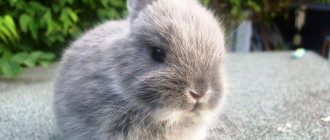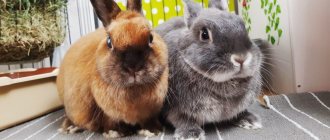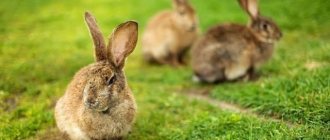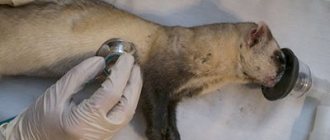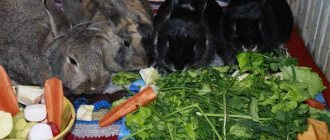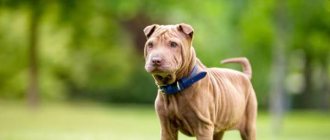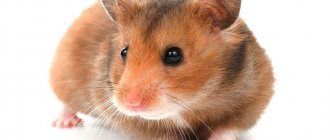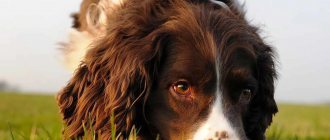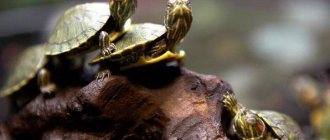Pets are found in almost every home. The decorative rabbit is rapidly gaining popularity. These animals do not need walks outside, take up little space, and are very easy to care for.
However, before you get such a pet, you should find out how long the animal lives, what to feed it and how to properly maintain it. The average life expectancy of dwarf rabbits is 6-12 years.
INTERESTING! The diet of such animals consists of vegetables, grains, fruits, twigs, hay, and licks. They especially love watermelons, sweet apples, carrots, and cucumbers.
PS. Prices are indicated with a wide range and are approximate. Much depends on where to buy a rabbit, under what conditions, availability of documentation, vaccinations and other important points.
Hermelin red-eyed and blue-eyed
There are two varieties of hermelin: with red or blue eyes. The first appeared at the end of the 19th century. Blue-eyed hermelines were obtained at the beginning of the 20th century. Initially, a weight of 750 grams was considered ideal, but in such females fertility was noticeably reduced.
Characteristic:
- Weight: 1100-1350 g.
- Ear length: 3.5-7 cm, straight.
- Wool: medium.
- Color: white.
- Price: 4-10 t.r.
In 1992, Austria released a new standard in which the weight of animals was changed. Hermelines have a strong build. The body is cylindrical, the limbs are short. The coat must be white.
Colored dwarf
The breed was founded by the German breeder Hoffmann. By 1957, he had received a fairly large population of different colors: Marder, black, gray, Siamese, blue, etc. This breed is distributed throughout the world and is the most numerous.
Peculiarities:
- Weight: 1000-1500 g.
- Ears: 5.5 cm, straight.
- Coat type: medium.
- Any colour.
- How much does it cost: 3-7 tr.
The body of a colored dwarf has the shape of a cylinder. The front legs are short, the head is quite large, but short. The coat is shiny, medium length, thick. There should be no dewlap. Any color is allowed.
Colored dwarf Dutch
A breed that was obtained in the Netherlands. It was officially recognized in 1940. To obtain it, they used hermelins and local small rabbits. Such animals appeared in Russia in 2013.
Characteristic:
- Weight: 800-1300 g.
- Ear length: 5-7.5 cm, straight.
- Wool: medium.
- Color: any.
- Price: 2-7 t.r.
Small rabbits whose weight should not exceed 1300 grams. The head has a rounded shape. The muzzle is wide, the eyes are round and large. The ears are located close to each other. The limbs are short and adjacent to the body.
Determination of gender
When buying a dwarf animal 1-2 months old, you can make a mistake in determining the gender of the animal. Small rabbits of the same breed are practically indistinguishable from each other. If a pet is purchased from a special nursery, then documents are attached that indicate the sex of the individual, as determined by specialists. And ordinary stores or the market do not give any guarantee in choosing a female or male ornamental hybrid.
To accurately determine whether it is a female rabbit or a rabbit in front of you, you should do certain simple manipulations:
- move the tail to the side and place the animal on its hind legs with its belly up;
- lift the animal by the withers with one hand, and squeeze the genitals with the fingers of the other;
- a female rodent will have a pink triangle, a male rodent will have a pointed penis.
Advice! The genitals of a dwarf rabbit originate immediately from the opening of the anus, and in a male rabbit they originate at a distance of about four centimeters.
Netherland dwarf rabbit
The ancestor of the breed is the red-eyed Hermelin. They have spread throughout the world. These rabbits were brought to Russia from Finland in 2014. There are two lines of the breed: English and American.
Peculiarities:
- Weight: 900-1150 g.
- Ears: 5-7.5 cm, straight.
- Coat type: medium.
- Any colour.
- Cost: 4-8 tr.
The ideal weight of an adult Netherland rabbit is 950 grams. The body is compact, the body has a rounded short format. The length of the ears varies from 5 to 7.5 cm. The breed standard includes 37 colors: solid, agouti, Siamese, tan, etc.
Polish rabbit or Dwarf hare
This dwarf rabbit is considered the smallest of all decorative breeds. Such animals came to Russia only in 2014. The most common Polish rabbits are in England and Scandinavian countries.
Characteristic:
- Weight: 500-1400 g.
- Ear length: 5-6 cm, straight.
- Wool: medium.
- Color: any.
- Price: 7-15 t.r.
Outwardly, these rabbits resemble a wild hare. The head is light and egg-shaped. The legs are long, thin, adjacent to the body. The coat is thick and about 2 cm long. Polish rabbits should not have dewlaps.
Walks
Home-kept decorative rabbits often suffer from vitamin D deficiency because they do not go outside. Walking in the fresh air is good for health, but only in dry, windless weather and in a secluded place.
It’s good if the owner of the animal has a dacha with a green yard, where you can install a spacious enclosure for your long-eared pet. The main thing is that it is partially in the shade of trees.
There is nowhere to walk a decorative rabbit in the city, except perhaps in park areas. However, in such places there is a high probability of stumbling upon the excrement of stray dogs and cats. The courtyards of high-rise buildings are too noisy - a timid rabbit is unlikely to enjoy a walk in such conditions. If there is a quiet place with a green lawn near your house, you can take your pet for a walk on a harness. But in this case, we cannot exclude the risk of infection with skin parasites - fleas and ticks, and helminths.
Dwarf rex
The first dwarf rexes appeared in France in 1919. They differ from other breeds in having very short hair. It is velvety and “plush” to the touch. Another feature is a short and curly mustache.
Peculiarities:
- Weight: 1000-1500 g.
- Ears: 3.5-7 cm, straight.
- Coat type: short.
- Any colour.
- Cost: 5-10 tr.
The Rex's body is stocky, compact, and slightly elongated. The length of the coat does not exceed 17-18 mm. It grows vertically and should not be curly or wavy. When stroking, the hairs return to their original position. The head is short, rounded, large. The eyes are large and expressive.
Satin dwarf
An American breed of rabbits with a special guard hair structure. It has a hollow shaft that reflects light well and gives the wool a unique shine. The first mutation occurred in 1934, after which these animals began to be purposefully bred.
Characteristic:
- Weight: 1500-2200 g.
- Ear length: 6-9 cm, straight.
- Wool: medium.
- Color: white, black, chocolate, red, chinchilla, Siamese, otter, opal.
- Price: 2-9 t.r.
A dwarf variety of satin rabbits was obtained not so long ago. Their body is slightly elongated, their back is rounded. The peculiarity of satin rabbits is their shining and iridescent fur, thanks to which it is impossible to confuse these animals with other breeds.
Fox dwarf rabbit
These animals were bred in Germany. To obtain them, ordinary medium-sized fox rabbits were crossed with miniature Hermelines, and dwarf Angora rabbits were also used to lengthen their fur.
Peculiarities:
- Weight: 1110-1250 g.
- Ears: 4-6.5 cm, straight.
- Coat length: medium-long.
- Any colour.
- Cost: 3-7 tr.
The fur of fox rabbits is thick and quite long (from 3.5 to 5 cm). It feels very soft and silky to the touch. The body is cylindrical, strong, and well-knit. The legs are short, the head is round and large.
Diseases
Common diseases
- VGBK;
- gastrointestinal stasis;
- urinary dermatitis;
- coccidiosis;
- myxomatosis;
- pasteurellosis.
If, during a period of heavy molting, a rabbit licks its own fur and the fur of a relative, then lumps of hair accumulate in the stomach. The result is bloating and constipation. There is a risk of intestinal blockage.
Rhinitis in rabbits: causes, symptoms, treatment methods
The main reasons are allergies, colds and infectious pathologies. Symptoms:
- swelling and redness of the nasal membrane;
- wheezing when breathing;
- the formation of crusts from dried secretions.
The animal constantly sneezes and scratches its nose.
Treatment uses drops that are instilled into the nasal passages. Medicines are prescribed by a veterinarian. Additionally, it is necessary to disinfect the rabbit corner.
Pasteurellosis in rabbits
The main symptom is an increase in general temperature to 40 degrees. The animal coughs, sneezes, and breathing becomes difficult.
Treatment uses injections. The medications are prescribed by a veterinarian.
Lion-headed dwarf rabbit
These animals were the result of a genetic mutation and appeared from crossing the Belgian dwarf and Swiss fox breeds. Subsequently, breeders used Angora dwarfs to improve the quality of the wool of lion-headed rabbits.
Characteristic:
- Weight: 850-1500 g.
- Ear length: 4.5-6 cm, straight.
- Coat: medium, long on the head.
- Color: any.
- Price: 5-9 t.r.
The peculiarity of such rabbits is very long hair around the ears and on the cheeks, forming a characteristic “mane”. At the same time, the hairs on the body do not exceed 3-5 cm in length. These animals are very common; they can be found more often than others in apartments and houses.
Practical advice
Basic tips:
- It is advisable to play with pets in the evening - during the day the animals sleep or hide;
- Rabbits often make noise at night. Therefore, it is necessary to teach them to adapt to their own routine - to accustom them to sleep at night;
- It is imperative to follow the vaccination schedule. During infectious outbreaks, the list of mandatory vaccinations may be expanded;
- to avoid the appearance of an unpleasant odor, the pet should be sterilized in a timely manner;
- To prevent your pet from starting to cause mischief, you should put pieces of wood in the cage - he will chew them;
- It is recommended to use small balls or boxes with holes as toys. If there are not enough toys, the rabbit will start tearing the wallpaper.
Most breeds do not get along well with cats and dogs. To prevent the rabbit from getting bored, it is best to move him with a fellow tribesman - preferably of the same breed.
Dwarf Angora
The first dwarf angoras appeared in Russia in 1997. They were brought from Poland. Breeders began active work to improve the breed and received a large group of animals with the same pubescence and body weight.
Peculiarities:
- Weight: 900-2000 g.
- Ears: 5-7.5 cm, straight.
- Coat length: very long.
- Color: white (with blue or red eyes), Siamese, yellow, black, blue, Havana, etc.
- Cost: 5-15 tr.
Outwardly, the Angora rabbit resembles a fluffy cloud. The fur of these animals is long and grows vertically. The head is very well pubescent, so the animals have almost no nose or eyes visible. These animals require regular grooming.
Feeding
Keeping a decorative rabbit requires the owner to know what to feed the eared pet. A properly formulated diet will help maintain the rodent’s immunity.
Basic feeding recommendations:
- feeders should be filled 2 times a day - morning and evening;
- the daily amount of feed for an adult rodent is 2-3 tablespoons;
- Before serving fresh grass, you must make sure that there are no poisonous plants among them;
- Fruits and vegetables should be offered chopped (in small pieces).
The rabbit's diet is based on roughage, the share of which reaches 60% of all food received. These are dry grain mixtures and hay. Pet stores sell feed for decorative rabbits. It contains oats, barley, beans and grass pellets. The composition of such food is correctly balanced, so that the pet receives all the substances necessary for health.
In addition to rough food, rodents need greens and vegetables. This food is called juicy. Decorative rabbits adore the stems and leaves of nettle, dandelion, plantain, as well as alfalfa, burdock and thistle. Among the vegetables, you can give the animal carrots, Jerusalem artichoke, cabbage, cucumbers, and pumpkin. Long-eared pets willingly eat apples and berries. In winter, it is advisable to introduce wheat sprouts into the animal’s diet; they contain a lot of vitamins.
Important! It is better to collect wild herbs for feeding rodents away from highways and industrial enterprises.
It is important for those who care for a decorative rabbit to know that mineral supplements must be present in its diet. This is bone meal, chalk, and salt in small quantities. Violation of the rules for keeping and feeding a rodent will lead to a decrease in immunity and the rapid death of the pet.
When caring for an animal, it is important to ensure that food does not stagnate or rot in the feeder.
Eating spoiled food is one of the reasons why rabbits kept at home die.
Dwarf ram
Dutch breed of domestic dwarf rabbits. To obtain it, ordinary French large rams were used. These animals are distinguished by their flexible disposition. They are quite phlegmatic, rarely show aggression, and are easy to keep.
Characteristic:
- Weight: 1400-2000 g.
- Ear length: 24-28 cm, drooping.
- Wool: medium.
- Color: any.
- Price: 10-15 t.r.
Small rabbits with long floppy ears. The head is round with large eyes and a wide, slightly flattened forehead. Rams have a wide back, a rounded back, and a strong and well-built physique.
REFERENCE! These animals are prone to gaining excess weight, so food should be given to them in portions and in limited quantities.
Interesting Facts
Those who want to know everything about decorative rabbits should study 11 interesting facts about them:
- Despite the fact that these animals are often called rodents, they actually belong to the order Lagomorpha.
- Rabbits have a special digestive system. They do not know how to regurgitate food, so a hairball or foreign object that gets into the stomach can lead to the most tragic consequences.
- Rabbits grow incisors throughout their lives, so they need to constantly grind them down. To satisfy this need, the animal gnaws on branches, cage bars, and while walking it can taste furniture, shoes, and even wires lying on the floor.
- The decorative rabbit has 28 teeth - 6 incisors and 22 cheeks.
- Puberty comes early. Already at the age of 3 months, rabbits can begin to reproduce.
- Pregnancy lasts about a month. Cubs are born blind and deaf, unlike hares.
- Mature males tend to defend their territory, so they can be aggressive. However, after castration, the character of decorative rabbits becomes softer and more flexible.
- These animals are quite smart. The animal can be trained to use the tray and even follow simple commands; it quickly remembers its nickname and responds to it.
- Decorative rabbits need physical activity, you need to give them the opportunity to walk every day.
- The animals are most active at dusk.
- Rodents can see everything to the side or behind, but they cannot see directly in front of them. The location of the eyes does not allow them to do this. Rabbits do not have a clear image; they see the world as if in a blurry picture.
Dwarf rex ram
To obtain these animals, such breeds of decorative rabbits as dwarf lop-eared rams and rexes were used. Breeding work began at the beginning of the 21st century. These animals appeared in Russia only in 2007. They were officially recognized in 2015.
Peculiarities:
- Weight: 1700-1900 g.
- Ears: 24-28 cm, hanging.
- Coat length: short, plush.
- Any colour.
- Cost: 7.5-20 t.r.
Quite rare and very beautiful animals. The body is of medium length, the head is rounded, slightly elongated. Fold-eared rex rams have round, expressive eyes and long ears. On the head there is a “crown” characteristic of the breed. The coat is short, velvety and plush to the touch.
Features of behavior
Domestic rabbits communicate with their owners using body language. By carefully observing your pet, you can guess what he wants to say:
- If the animal is completely relaxed, it should not be disturbed. Especially when he's lying on his side and looks like he's dead. In this position he feels most comfortable. Perhaps he felt so comfortable and good that he fell asleep.
- Licking the owner's hands is a sign of special affection. With this behavior, decorative rabbits demonstrate a friendly attitude. After all, when rodents living together clean and wash each other, they show that they recognize that their relative belongs to their pack.
- The decorative rabbit rose on its hind legs and stretched its neck. This means that he is interested in some subject. The pet wants to take a closer look at it or tries to reach for the treat.
- The animal constantly rummages in the litter, as if looking for or hiding something. Most likely, the rodent is building a hole. Females usually do this during nesting.
- The animal puts its muzzle to the palm and pushes. This is how he shows that he wants to receive another portion of affection and attention.
- The pet presses its ears and shrinks into a ball. This indicates severe fear or wariness. Perhaps he saw a stranger or heard a sharp sound. The feeling of danger is always accompanied by instinctive muscle contraction. The animal also flattens its ears when it is angry and ready to fight. At such moments, he raises his muzzle. It is better not to approach your pet, but wait until he calms down, and then treat him to a carrot or other treat.
- A domestic rabbit bit my hand. Obviously he didn't like the rough treatment. A pet may bite when it is forcibly pulled out of its cage or pressed too hard. This is why children should be taught how to properly handle an animal.
- The animal grinds its teeth or makes a quiet muttering sound. This is how the pet shows that he enjoys stroking.
The habits characteristic of most rodents are described above. However, each animal has its own character, so the behavior of decorative rabbits under different circumstances may differ.
Lion-headed dwarf ram
To obtain such animals with an unusual appearance, dwarf rams and lion-headed rabbits were used. The breed was officially recognized in 2007 in the UK. In Russia this happened in 2010.
Characteristic:
- Weight: 1600-2200 g.
- Ear length: 24-27 cm, drooping.
- Coat: medium, long on the head.
- Color: any.
- Price: 4.5-12 t.r.
The lion-headed ram has a dense, cylindrical body. The ears are long, hanging, rounded at the ends. The coat on the body is of medium length, but around the ears and on the cheeks it is noticeably longer (up to 15-18 cm).
Dutch lop-eared dwarf rabbit
The first representatives of the breed were obtained about 30 years ago. To breed them, breeders crossed Dutch rabbits and French fold rams. For several years, experts have been working to reduce the size of the breed.
Peculiarities:
- Weight: 1250-1700 g.
- Ears: 21-26 cm, hanging.
- Coat length: medium.
- Color: brown, gray, black, blue, marten, isabella, black otter, chinchilla.
- Cost: 3.5-8 tr.
The body of these animals is strong, the back is rounded. Skin without folds, dewlap is not allowed. The head is quite large and round in shape. The neck is short. The eyes of Netherland rabbits are large and expressive.
Mini lop
The breed was bred in Germany. These animals were obtained by crossing Dutch fold rams and dwarf chinchillas. The first mini-lops were white, but later other colors were obtained. The breed was officially recognized in 1980.
Characteristic:
- Weight: 1400-2700 g.
- Ear length: should be 2-3 cm below the jaw, drooping.
- Wool: medium.
- Color: any.
- Price: 8-17 t.r.
Mini lop has a strong body. The head is rounded and quite large. The neck is very short. The limbs are thick, not curved, and short. These rabbits are very good-natured, so even small children can communicate with them without any problems.
Vaccinations
A dwarf pet of any breed must be vaccinated against myxomatosis and hemorrhagic viral disease. Such vaccines can be administered in combination or as a single component. Rabbits are delicate animals that do not tolerate various infections well, so overdue vaccinations can contribute to the death of the ornamental animal. For vaccination, it is better to contact a qualified veterinarian who will determine the age of the pet, the need for medication and the next steps regarding the health of the rodent.
Mini lop lionhead
These animals were obtained in England in the early 2000s, but they are not yet officially recognized. The best representatives of the lion-headed dwarf and mini lop breeds were used for breeding.
Peculiarities:
- Weight: 1500-1600 g.
- Ears: 21-25 cm, hanging.
- Coat length: medium, long in the head area (up to 7.5 cm).
- Any colour.
- Cost: 6-13 tr.
These animals are quite miniature. A characteristic feature of the breed is a very thick mane on the head, while the hair on the body is short (no more than 2 cm). The body is dense, strong, the back is rounded. Lion-headed mini-lops have a round head proportional to the body.
Mini lop cashmere (long-haired)
The first long-haired rabbits were obtained by chance in a litter of standard dwarf rams. This happened in 1980 in England. It was these animals that became the founders of the Cashmere Mini Lop breed.
Characteristic:
- Weight: 1300-1600 g.
- Ear length: 20-24 cm, drooping.
- Coat: long (from 3.8 to 5-6 cm), shorter on the head.
- Color: any.
- Price: 7.5-13 t.r.
Cashmere mini lop has a dense, strong, but small body. The croup is rounded. The neck is very short, almost invisible. Both the forelimbs and hind limbs are thick and short. The peculiarity of the breed is its long, soft, but not plump, hair that is always straight.
Holland lop
This breed is the result of crossing Dutch dwarf rams and French lops (the weight of these rabbits reaches 4.5 kg). It was officially recognized in America in 1979.
Peculiarities:
- Weight: 1400-1800 g.
- Ears: 12 cm, drooping.
- Coat type: medium.
- Color: fawn, silver, chocolate, white, brown, red.
- Cost: 8-14 tr.
A distinctive feature of Holland Lop rabbits is their almond-shaped ears. Their average length is 12 cm. The body of rabbits is muscular, strong, and the back is rounded. The legs are short and thick, very strong.
Breeds of dwarf rabbits are numerous and varied. At home, they are kept both in cages and freely. They do not require complex care, and most of them have a good-natured and easy-going character.
Caring for a cat after castration in the first hours
After castration, a cat needs special care. Most veterinary clinics provide post-operative hospital services. In a special box with optimal climatic conditions, the operated pet is observed until it completely recovers from anesthesia. Once convinced that the cat’s condition is satisfactory, it is handed over to its owners.
Care in the first hours after castration comes down to monitoring your pets
If such a service is not available in the clinic or castration is performed at home, it is important to follow the following care recommendations:
To transport a cat after castration, it is recommended to use a loose carrier with a folding top and an absorbent diaper on the bottom. It is forbidden to transport an operated pet in your arms or in a car seat, as when waking up from anesthesia, it can harm itself or its owner. During transportation and further postoperative stay, the cat is placed on its side; It is recommended to lay an anesthetized, operated cat on the floor, since when it comes to its senses, it may fall off the table/sofa/bed. A common symptom of anesthesia sleep is uncontrollable urination. Using an absorbent diaper placed on the floor under the pet will make it much easier to eliminate such a nuisance; During anesthetized sleep, body temperature drops by 1-1.5°, so to prevent hypothermia, the operated pet is placed next to a heating radiator. It is strictly forbidden to place animals near electrical appliances with an open heating element. Instead of a battery, you can use a heating pad or a plastic bottle with hot, but not boiling water, which is placed next to the cat under a bedding or blanket
It is important that the heat does not come into contact with the cat's perineum, as this will cause bleeding. During the warm season, no additional warming procedure is required; for a more comfortable awakening from anesthesia sleep, it is recommended to close the curtains on the windows, since bright sunlight causes irritation of the optic nerve; Anesthesia sleep lasts from 15 to 120 minutes. depending on the method of administration and dose of the drug
During this time, it is necessary to monitor the cat so that it does not bury its nose in anything and suffocate. In addition, cats in this condition do not blink, which can cause the cornea to dry out. It is recommended to drip sterile saline solution, contact lens liquid, or eye drops without antibiotics into the eyes several times;
A protective collar will prevent your pet from licking the wound, further irritating it.
- Often waking up after anesthesia causes aggression in the pet. Therefore, it is recommended to provide the cat with complete rest for 24 hours, limiting access to him by other animals or children. It is forbidden to forcefully wake up your pet. Depending on the individual characteristics, after waking up, the cat may experience an unsteady gait, vomiting, involuntary urination, and a lethargic and drowsy state. This condition can last up to 8 hours, which is normal and should not cause concern;
- the wound on the scrotum after castration is not sutured, so it is recommended to minimize the amount of filler in the tray or replace it with absorbent paper. This will prevent the ingress of small filler particles and subsequent complications;
- A few hours after surgery, there may be slight bleeding from the incision, which is normal and safe for the cat. You can lightly dry the wound with a gauze cloth. In case of significant bleeding of more than 1 ml, you should urgently contact the doctor who performed the operation;
- Medicines prescribed by a veterinarian will help relieve pain. You can tell that a cat needs pain medication by dilated pupils, meowing, pursed paws, and aggression when attempting contact;
- You can prevent the possibility of damage to the healing incision by the cat’s rough tongue during hygiene by wearing a protective collar around the neck for several days. Such a product will limit the cat’s access to the wound without affecting food intake in any way.
Note! Veterinarians recommend castration in the fall or winter months, as during this period the likelihood of infection of the incision during rehabilitation is lower. In the summer, as a preventive measure for infection, the doctor prescribes a 5-day course of antibiotic treatment.

